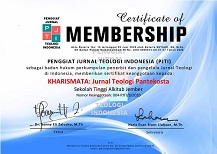Dari Paha Yakub ke Duri Paulus: Kelemahan dan Kekuatan dalam Teologi Alkitabiah
DOI:
https://doi.org/10.47167/t9kss294Keywords:
Jacob, Paul, strength, suffering, weaknessAbstract
This article examined how human weakness became a space for manifesting divine power through a comparative study of Jacob's experience at Pniel (Genesis 32:25–32) and Paul's thorn in the flesh (2 Corinthians 12:7–10). The study addressed the problem of how suffering shaped identity and functioned as a means of revealing God's power. It aimed to explore the theological significance of these experiences in light of the Hebrew concept of shamar (?????? nurturing/thorns). The methods used included linguistic, historical-cultural, and typological-canonical approaches. The study shows that weakness is not a barrier but a vessel of grace. In the cases of Jacob and Paul, suffering leads to a transformation of identity and empowerment for ministry. The study concludes that, in the biblical tradition, human weakness is often God's way of forming, preserving, and fully revealing Himself in the lives of His people.
Artikel ini membahas bagaimana kelemahan manusia menjadi ruang bagi manifestasi kekuatan ilah. Melalui studi komparatif terhadap pengalaman Yakub di Pniel (Kejadian 32:25–32) dan duri dalam daging Paulus (2 Korintus 12:7–10). Permasalahan yang diangkat adalah bagaimana penderitaan membentuk identitas dan menjadi sarana pewahyuan kuasa Allah. Tujuan penelitian ini adalah mengkaji makna teologis dari pengalaman tersebut dalam terang konsep Ibrani ?????? shamar (memelihara/duri). Metode yang digunakan adalah pendekatan linguistik, historis-kultural, dan tipologis-kanonikal. Hasil penelitian menunjukkan bahwa kelemahan bukan penghalang, tetapi justru wadah kasih karunia. Dalam kasus Yakub dan Paulus, penderitaan berujung pada transformasi identitas dan kuasa pelayanan. Kesimpulan dari studi ini adalah bahwa dalam tradisi biblika, kelemahan yang dialami manusia seringkali merupakan cara Allah membentuk, menjaga, dan menyatakan diri-Nya secara penuh dalam kehidupan umat-Nya.
Downloads
References
Adebayo, Faith O. “An Examination of Scriptural and Archaeological Evidences for the Historicity of Biblical Patriarchs.” Asian Journal of Humanities and Social Studies 3, no. 5 (2015).
Belleville, Linda L. “‘Weakness and Power: Paul’s Understanding of the Christian Ministry in 2 Corinthians.,’” 1995.
Benner, Jeff A. Ancient Hebrew Lexicon of the Bible, 2005.
Bentorah, Chaim. Hebrew Word Study: Revealing the Heart of God, 2014.
Blum, Erhard. “• ‘Jacob at Peniel: The History of a Struggle.’” Vetus Testamentum 56, no. 2 (2006).
Boer, Roland. “The Patriarch’s Nuts: Concerning the Testicular Logic of Biblical Hebrew.” Journal of Men, Masculinities and Spirituality 5, no. 2 (2011): 41.
Buth, Randall, Cynthia L Miller-Naudé, Jacobus A Naudé, Kaspars Ozoli?š, Sophia L Pitcher, William Ross, Wido van Peursen, et al. Linguistic Theory and the Biblical Text. Semitic Languages and Cultures, 2023.
Christiansen, Daniel L. “Rhetoric, Gender, Weakness, and Shame : Paul’s Somatic Self-Presentation in the Corinthian Correspondence,” 2015.
Collins, Adela Yarbro. “Paul’s Disability: The Thorn in His Flesh.” 165–183, 2011.
Dryden, Jeffrey de Waal. “Benjamin G. White. Pain and Paradox in 2 Corinthians: The Transformative Function of Strength in Weakness.” Bulletin for Biblical research 32, no. 4 (2022): 472–474.
Dunn, James D. G. The Theology of Paul the Apostle. Grand Rapids: Eerdmans., 1998.
Freni, Giulia. “ANCIENT DESCRIPTIONS OF PAIN - (J.R.) Clarke, (D.) King, (H.) Baltussen (Edd.) Pain Narratives in Greco-Roman Writings. Studies in the Representation of Physical and Mental Suffering. (Studies in Ancient Medicine 58.) Pp. Xiv + 312, Colour Ills. Leiden An.” Classical review (2024): 1–2.
Gerhardsson, Birger, and Eric J Sharpe. Memory and Manuscript : Oral Tradition and Written Transmission in Rabbinic Judaism and Early Christianity ; with, Tradition and Transmission in Early Christianity, 1998.
Goodacre, Mark. “Scripturalization in Mark’s Crucifixion Narrative” (2006).
Goodrich, John Kenneth. “Paul, the Oikonomos of God : Paul’s Apostolic Metaphor in 1 Corinthians and Its Graeco-Roman Context,” 2010.
Hafemann, Scott J. “‘Paul’s “Thorn in the Flesh”: New Clues for an Old Problem.’” Journal of Biblical Literature 112, no. 1 (1993): 55–75.
Hays, Richard B. The Moral Vision of the New Testament: A Contemporary Introduction to New Testament Ethics. HarperCollins ebooks, 1996.
Himmelfarb, Martha. “‘Az Mi-Lifnei Vereishit’: The Suffering Messiah in the Seventh Century.” 367–384, 2014.
Hodossy-Takács, El?d. “Jacob, Laban, and the World of the Near Eastern Nomads.” Studia Universitatis Babe?-Bolyai (2024).
IMBRISCA, Ionut Eremia. “La Debolezza è La Mia Forza: Meditazioni Su 2Cor.” Deleted Journal XXVII, no. 53 (2024): 129–144.
Imbrisca, Ionu? Eremia. “La Debolezza Di Paolo e La Grazia Di Dio Nella Seconda Lettera Ai Corinzi” (2022).
Katz, Ben Zion. “The Function of the Root Y-R-Kh in Genesis.” Jewish Bible Quarterly 37, no. 3 (2009): 189.
Lehmhaus, Lennart. “Talmudic Torment: Late Antique Jewish Texts on Pain and Suffering Between Medicine, Martyrdom, and Askesis.” Journal of Early Christian History (2022): 1–28.
Liebermann, Rosanne. “Pain and Suffering in the Hebrew Bible,” 2024.
McLaughlin, Eric. “Strength in Weakness: A Mystery of Hope.” Christian Journal for Global Health 11, no. 2 (2024): 35–39.
Mullins, Terence Y. “Paul’s Thorn in the Flesh.” Journal of Biblical Literature 76, no. 4 (1957): 299.
Nouwen, Henri J.M Nouwen. The Wounded Healer: Ministry in Contemporary Society. Doubleday, 1979.
Peña, Ignacio García. “Ética Del Dolor y Terapéutica En La Filosofía Griega” 6, no. 7 (2017): 510–535.
Placher, William C. Narratives of a Vulnerable God: Christ, Theology, and Scripture, 1994.
Prinsloo, Gert T M. “Suffering Bodies - Divine Absence : Towards a Spatial Reading of Ancient near Eastern Laments with Reference to Psalm 13 and an Assyrian Elegy (K 890).” Old Testament essays 26, no. 3 (2013): 773–803.
Roberts, John M. “Oaths, Autonomic Ordeals, and Power1.” American Anthropologist 67, no. 6 (2009): 186–212.
Ross, William. “Cognitive Linguistic Theory and the Biblical Languages.” In Semitic Languages and Cultures, 117–171, 2023.
Russell, Ronald. “Redemptive Suffering and Paul’s Thorn in the Flesh” (1996).
Samellas, Antigone. “Public Aspects of Pain in Late Antiquity: The Testimony of Chrysostom and the Cappadocians in Their Graeco-Roman Context.” Zeitschrift Fur Antikes Christentum-journal of Ancient Christianity 19, no. 2 (2015): 260–296.
Shearman, Susan Lee, and John Briggs Curtis. “Divine-Human Conflicts in the Old Testament.” Journal of Near Eastern Studies 28, no. 4 (1969): 231–242.
Soon, Isaac T. “God and the Disabling of Paul.” 68–81, 2023.
Suratman, Efesus. “Pemaknaan ‘Duri Dalam Daging’ Di 2 Korintus 12:7 Sebagai Penguatan Dalam Menghadapi Penderitaan Orang Percaya.” Kharismata : Jurnal Teologi Pantekosta 6, no. 1 (2023): 130–148.
White, Benjamin Grant. “Pain and Paradox : The Transformative Function of Strength in Weakness in 2 Corinthians,” 2019.
Wright, N. T. Paul and the Faithfulness of God. Minneapolis: Fortress Press., 2013.
Wyner, Mark Elizabeth. The Covenant of Circumcision : New Perspectives on an Ancient Jewish Rite, 2003.
Yoreh, Tzemah. “Jacob’s Struggle.” Zeitschrift für die Alttestamentliche Wissenschaft 117, no. 1 (2005): 95–97.
Zakovitch, Yair. Jacob: Unexpected Patriarch. New Haven: Yale University Press, 2012.
Zamore, Zachary, Mark D Schuenke, and Mark D Schuenke. “The ‘Genesis’ of Sciatic Nerve Injury.” Journal of Plastic Reconstructive and Aesthetic Surgery 95 (2024): 216–220.
“Re-Remembering Hagar: Reading the ???? in Galatians with Hortense Spillers.” Journal of Biblical Literature 142, no. 2 (2023): 305–324.
Downloads
Published
Issue
Section
License
Copyright (c) 2025 KHARISMATA: Jurnal Teologi Pantekosta

This work is licensed under a Creative Commons Attribution-NonCommercial-ShareAlike 4.0 International License.








